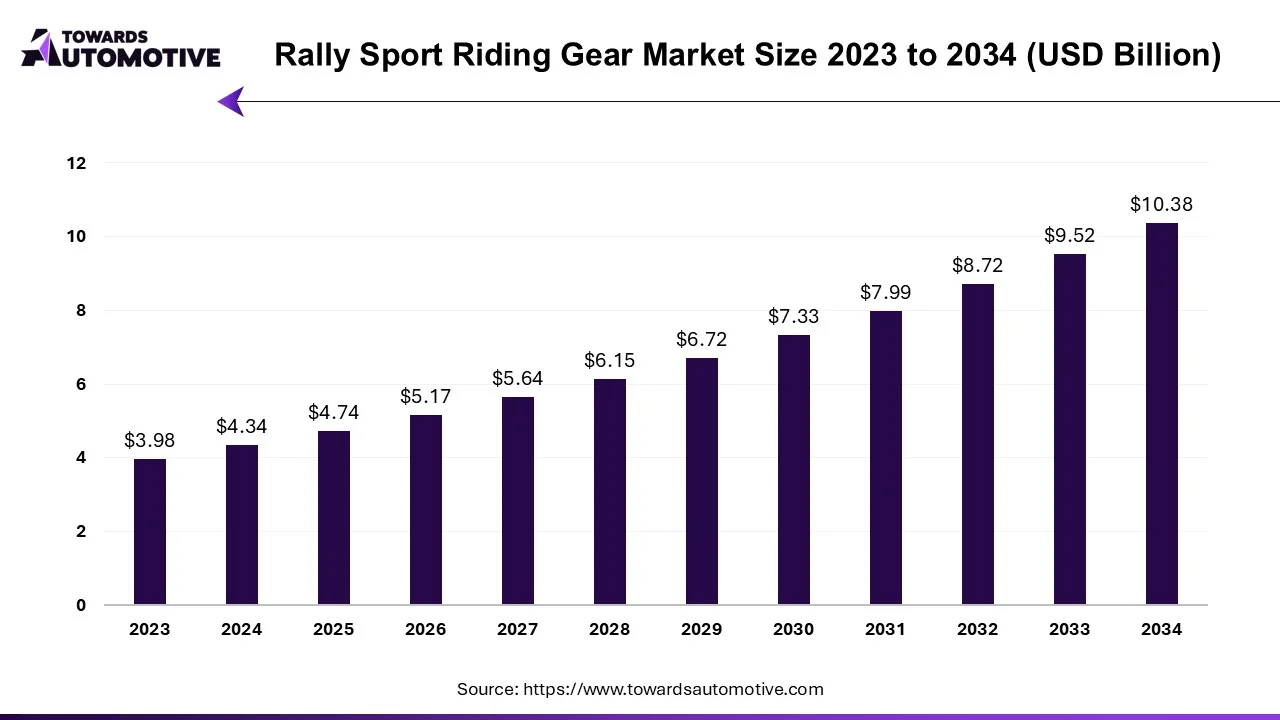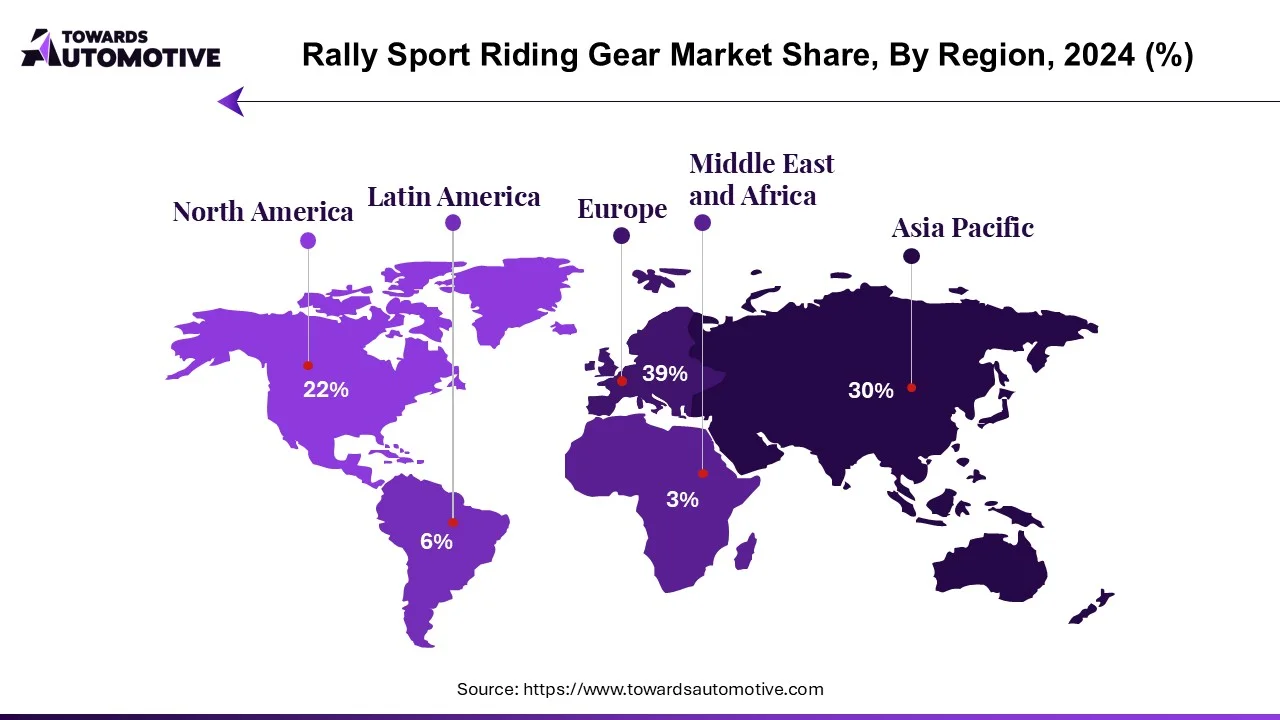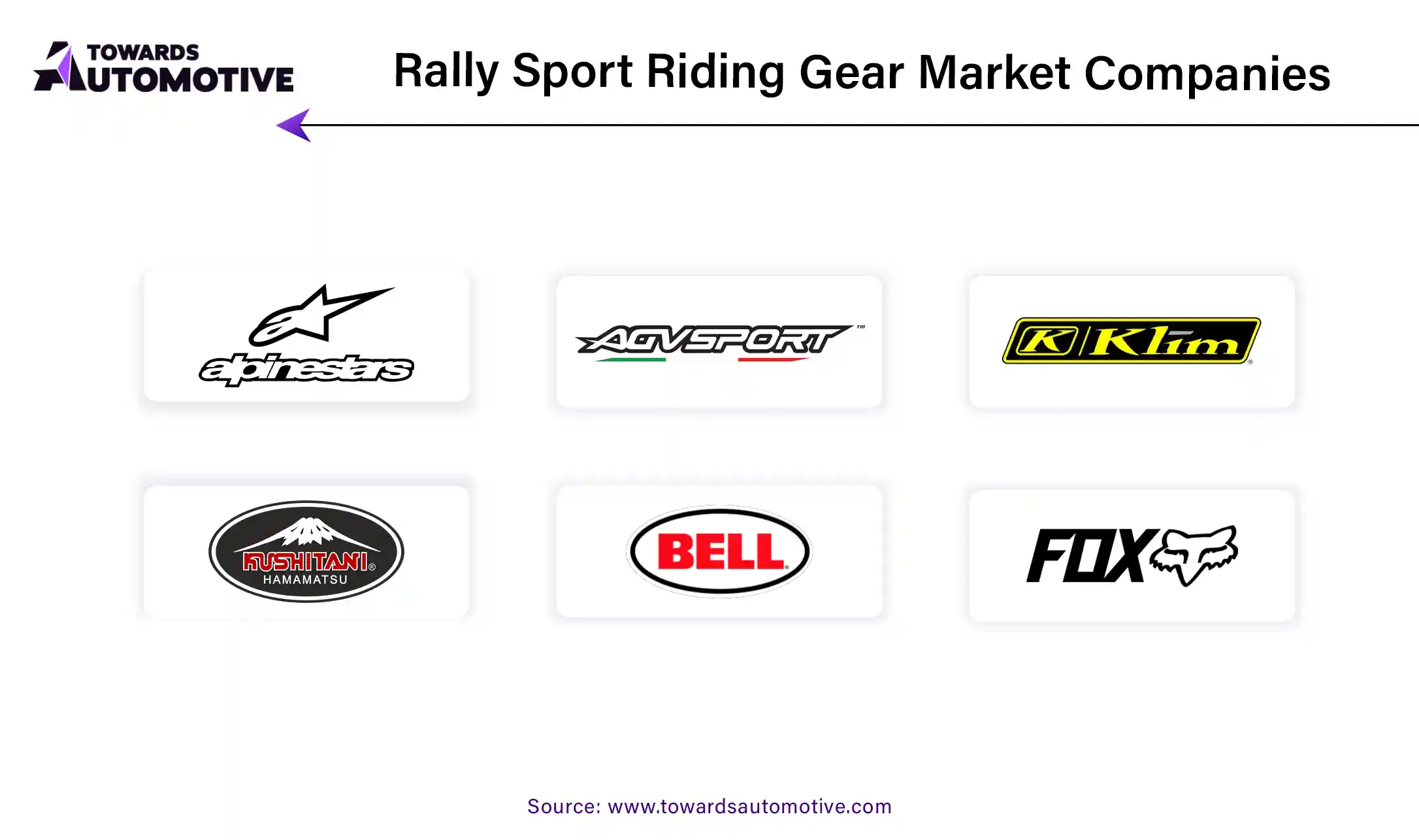July 2025
The rally sport riding gear market is anticipated to grow from USD 4.74 billion in 2025 to USD 10.38 billion by 2034, with a compound annual growth rate (CAGR) of 9.11% during the forecast period from 2025 to 2034.

Unlock Infinite Advantages: Subscribe to Annual Membership
The rally sport riding gear market is undergoing a period of dynamic growth, spurred by a burgeoning interest among enthusiasts who actively participate in off-road motorsports. This upward trend is driven by a multitude of factors, including the growing popularity of rally sports events, the expanding community of motorsport enthusiasts, and the increasing availability of advanced riding gear tailored specifically for rally sports activities.
Manufacturers within the industry are responding to this heightened demand by intensifying their focus on product innovation. They are committed to developing riding gear that not only meets the rigorous safety standards demanded by rally sports but also delivers exceptional durability and comfort to riders. Moreover, there is a concerted effort to infuse these products with stylish designs, appealing to consumers who seek both performance and aesthetic appeal in their riding gear.
One of the most notable trends shaping the market is the integration of cutting-edge technologies into rally sport riding gear. Smart sensors, communication systems, and other advanced features are being incorporated into these products, enhancing their functionality and providing riders with enhanced performance and safety capabilities.
As rally sports continue to gain traction and visibility, propelled by increased media coverage and growing fan engagement, the rally sport riding gear market is poised for sustained growth. This presents an array of opportunities for manufacturers, retailers, and other stakeholders to capitalize on the burgeoning demand for high-quality riding gear tailored to the unique needs of rally sports enthusiasts. The convergence of innovation, safety, and style underscores the market's potential for expansion, making it an exciting and dynamic sector within the broader motorsports industry.
Technological innovation has become a driving force behind the evolution of the competitive sports equipment market, ushering in a new era characterized by enhanced safety, performance, and comfort for athletes. Manufacturers have been at the forefront of this transformation, relentlessly pursuing the development of innovative products that push the boundaries of what's possible in sports gear design. One of the most notable advancements is the development of advanced protective systems, incorporating materials such as high-density foam, gel, or air strategically placed within the gear to minimize the risk of injuries during accidents or falls.
Moreover, lightweight yet durable materials like ballistic nylon, Cordura, or Kevlar have revolutionized sports equipment, offering athletes superior durability, abrasion resistance, and tear strength without compromising on flexibility or mobility. This has been instrumental in providing athletes with the confidence to push their limits without fear of compromising their safety. In addition, ventilation systems and moisture-wicking fabrics have been integrated into sports gear to combat sweat and heat buildup during intense competition, ensuring athletes remain cool and comfortable even in the most demanding conditions.
Communication systems have also played a crucial role in enhancing athlete performance, particularly in racing sports where effective communication between drivers, teams, and support staff is paramount. Bluetooth-enabled intercom systems, helmet speakers, and microphones have enabled seamless communication, allowing athletes to receive important instructions or updates without diverting their attention from the race. Furthermore, the integration of IoT capabilities into sports gear has opened up new possibilities, with built-in sensors monitoring vital data such as heart rate, body temperature, and impacts to provide athletes with real-time feedback and performance analysis.
Weather-adaptive gear has emerged as another key innovation, allowing athletes to customize their equipment for optimal comfort and protection in diverse weather conditions. Removable padding, waterproof membranes, and insulation ensure athletes can perform at their best regardless of the external environment. Augmented reality (AR) and head-up display (HUD) technologies are also being explored to provide athletes with real-time information without distracting them from the task at hand. Helmet-mounted displays or clear goggles can project essential data such as direction, speed, or lap times to enhance situational awareness and performance.
Lastly, energy efficiency initiatives have gained momentum in sports competitions, with athletes harnessing their energy or utilizing kinetic energy generated by solar panels on their gear to power communication devices, GPS trackers, or even harness heat energy from natural sources in colder climates. These technological advancements have reshaped the competitive sports equipment market, offering athletes unprecedented levels of safety, comfort, and efficiency. As technology continues to evolve, the future promises further growth and innovation in sports gear design, empowering athletes to reach new heights in their performance.

Europe stands as the leading market for competitive sports equipment, owing to its rich motorsport heritage, vibrant rally events, and passionate drivers. The region's prominence in the competitive sports market is underpinned by several key factors.
Firstly, Europe boasts a deeply ingrained motorsport culture, hosting prestigious events like the World Rally Championship (WRC) alongside numerous national and international competitions. This longstanding tradition fuels a robust demand for top-tier racing equipment among professionals, cycling enthusiasts, and sports aficionados alike.
European Rallycross events draw significant local and international participation, driving the need for specialized equipment that meets stringent safety and performance standards. This spurs rapid development and innovation in rally sports gear within the region.
Europe is home to a plethora of renowned motorsport manufacturers, racing teams, and equipment suppliers. The region's thriving competitive economy facilitates the development, production, and distribution of cutting-edge sports equipment, offering a wide array of high-performance options to enthusiasts.
Stringent regulations and competition standards prevalent in Europe mandate sports equipment compliance with specific safety and certification requirements. Heightened concerns surrounding rider safety propel the demand for premium cycling gear that not only ensures adequate protection but also meets rigorous safety standards.
Additionally, Europe boasts a vibrant rider community and numerous motorcycle associations actively involved in organizing and participating in racing events. These communities and organizations serve as catalysts for promoting sports and fostering camaraderie among enthusiasts, thereby driving market growth through collaboration and advocacy.
The region's stable and prosperous economy creates an ideal environment for competitive sports equipment, with affluent consumers exhibiting a strong inclination towards investing in quality driving gear. This consumer enthusiasm, coupled with a passion for motorsports, propels market expansion as European riders continue to seek out top-of-the-line equipment and cutting-edge technology.
Europe's reputation for driving and engineering excellence fosters a culture of innovation among manufacturers and suppliers. This relentless focus on enhancing performance, safety, and innovation propels the industry forward, attracting riders in search of premium equipment for competitive racing.
Europe's robust racing culture, high levels of participation, thriving motorsport industry, stringent safety standards, passionate rider base, economic prosperity, and commitment to quality and innovation collectively position it as a premier destination for competitive sports equipment. As such, the region's core market is poised for sustained growth, driven by the unwavering demand for superior equipment and technological advancements.
The competitive sport riding market is characterized by fragmentation, with several key players such as Alpinestars, AGV Sports, Bell Helmets, and FLY Racing exerting significant influence. In this competitive landscape, investment in innovation and security stands out as primary strategies adopted by most market participants. These companies prioritize the development of cutting-edge technologies and safety features to enhance the performance and protection offered by their products.
Players in the market actively engage in supporting riders and racing teams to promote their brands and products. This collaboration serves to showcase the efficacy and reliability of their gear in demanding competitive environments, fostering trust and brand loyalty among consumers.
For Instance,
Such partnerships underscore the industry's commitment to driving innovation and catering to the evolving needs of riders worldwide. By combining forces, companies in the competitive sport riding market can leverage synergies to develop superior products and strengthen their market position in an increasingly competitive landscape.

Racing equipment plays a pivotal role in the world of competitive motorsports, providing riders with specialized attire and protective gear essential for their safety and performance during high-speed events, particularly in rally sports. Designed to withstand the demanding conditions of off-road racing, rally sports gear is engineered to offer a balance of durability, flexibility, and protection against the hazards inherent in such competitions.
This segment of the motorsports industry is characterized by a diverse range of products, including helmets, body armor, gloves, boots, and other accessories, each meticulously designed to meet the unique needs of rally drivers and riders. From advanced materials that offer superior impact resistance to innovative ventilation systems that help regulate temperature and moisture, rally sports gear is continuously evolving to enhance rider safety and comfort.
The market for rally sports equipment is segmented based on various factors, including brand, rally type, and geographical region. Brands such as Alpinestars, AGV Sports, and Bell Helmets are among the leading players in the industry, known for their commitment to innovation and quality. Rally sports events encompass a wide range of competitions, from cross-country rallies to endurance races, each requiring specialized gear tailored to the specific demands of the course and terrain.
Geographically, the market for rally sports gear is distributed across regions such as North America, Europe, Asia Pacific, and the Rest of the World, reflecting the global nature of the motorsports industry and the widespread popularity of rally sports across different continents. Each region may have its own unique preferences, regulations, and market dynamics, influencing the demand for different types of racing equipment.
Overall, the market for rally sports gear continues to experience steady growth and innovation, driven by the increasing popularity of motorsports and the rising demand for high-quality equipment among professional racers and enthusiasts alike. As technology advances and safety standards evolve, manufacturers are poised to continue developing cutting-edge products that push the boundaries of performance and protection in rally sports.
By Type
By Rally Vehicle Type
By Geography
July 2025
April 2025
April 2025
April 2025
We offer automotive expertise for market projections and customizable research, adaptable to diverse strategic approaches.
Contact Us